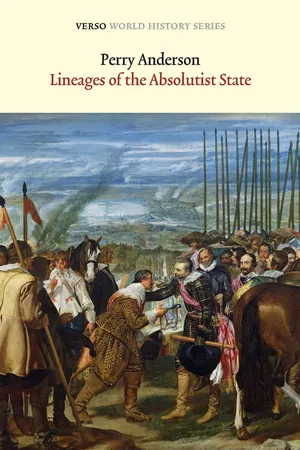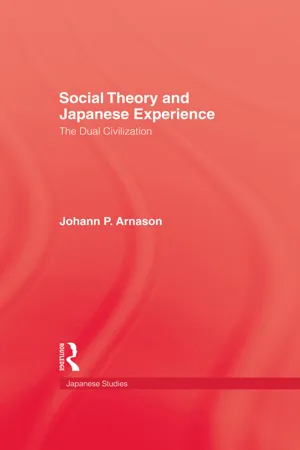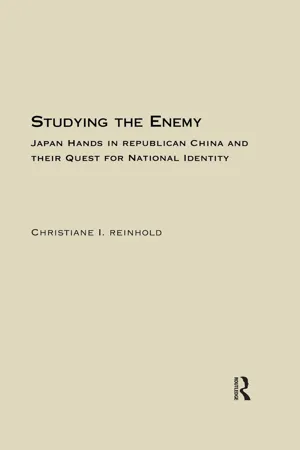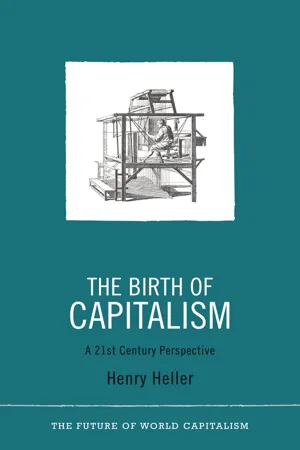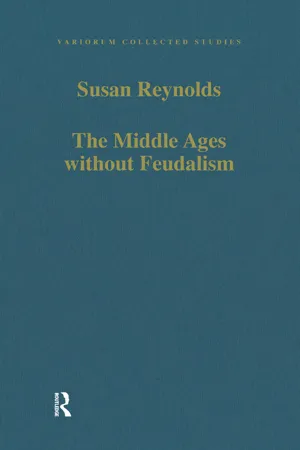History
Feudalism in Japan
Feudalism in Japan was a hierarchical social system that emerged during the Kamakura period (1185-1333) and lasted until the Meiji Restoration in 1868. It was characterized by a decentralized political structure, with power held by regional warlords known as daimyo, who pledged loyalty to the shogun. Samurai warriors served the daimyo and held significant influence in Japanese society.
Written by Perlego with AI-assistance
Related key terms
11 Key excerpts on "Feudalism in Japan"
- eBook - ePub
- Harald Kleinschmidt, Harald Kleinschmidt(Authors)
- 2017(Publication Date)
- Routledge(Publisher)
Part I Feudalism in JapanPassage contains an image
JOHN WHITNEY HALL[ 1 ] Feudalism in Japan—A ReassessmentThe question of whether Japan can rightly be said to "have had feudalism" is by no means settled. Although Westerners have been writing about "Japanese feudalism" for well over a hundred years, the acceptability of this practice is still a matter of controversy among professional historians, notably among those who make the study of medieval Europe their specialty. To a long line of Western historians ending with Herbert Norman, however, there was no question about the appropriateness of placing the feudal label on Japan. Nor does the contemporary Japanese historian question a term which has become so important a part of his professional as well as everyday vocabulary. In a Japan in which the reading public is daily reminded that the "struggle against feudalism" is still being waged, feudalism seems a present reality which by its very nature cannot be denied to have existed in Japan's past.To the Japanese historian of today Feudalism in Japan is not only real, it is also the same universal reality against which the "more progressive" Western peoples had to struggle before their eventual emancipation. As Nagahara Keiji has put it,It is now generally accepted that capitalism in Japan developed upon a foundation laid in the semi-feudal land ownership pattern of the villages. The power of the feudalists landlords and the bourgeoisie, though on the surface full of mutual contradictions, served fundamentally to reinforce each other, leading inevitably to the military defeat of August 15th. Although it appeared at first that the land reform had decisively revolutionized the self-reinforcement of these two groups, dissolving large-scale landlordism and high rent tenancy and thereby destroying the feudal relationships within the village, actually it did not produce any such fundamental change. To the contrary, recent studies have shown that it resulted in a re-strengthening of feudal relationships under colonial control.1 - eBook - ePub
- Perry Anderson(Author)
- 2013(Publication Date)
- Verso(Publisher)
28 For our purposes here, the essential interest of this Far Eastern feudalism lies in its distinctive combination of structural similarities and dynamic divergences from European evolution.The Japanese feudalism which emerged as a developed mode of production from the 14th-15th centuries onwards, after a long period of prior incubation, was characterized by essentially the same essential nexus as European feudalism: the fusion of vassalage, benefice and immunity into a fief system which constituted the basic politico-legal framework in which surplus labour was extracted from the direct producer. The links between military service, conditional landowner-ship and seigneurial jurisdiction were faithfully reproduced in Japan. The graded hierarchy between lord, vassal, and rear-vassal, to form a chain of suzerainty and dependence, was equally present. An aristocracy of mounted knights formed a hereditary ruling class: the peasantry was juridically bound to the soil in a close replica of glebe serfdom. Japanese feudalism also, of course, possessed local traits of its own, which contrasted with European feudalism. The technical conditions of riziculture dictated different village structures, which lacked a three-field system. The Japanese manor, for its part, rarely contained a demesne or home-farm. More importantly, within the intra-feudal relationship between lord and overlord, above the village level, vassalage tended to predominate over benefice: the ‘personal’ bond of homage was traditionally stronger than the ‘material’ bond of investiture. The feudal compact was less contractual and specific than in Europe: the duties of a vassal were more diffuse and the rights of his liege more imperative. Within the peculiar balance of honour and subordination, reciprocity and inequality, which marked the feudal tie, the Japanese variant was consistently tilted towards the second term. Although clan organization was – as in all true feudal social formations – superseded, the expressive ‘code’ of the lord-vassal relationship was provided by the language of kinship, rather than the elements of law: the authority of the lord over his follower was more patriarchal and mquestionable than in Europe. Seigneurial felony was foreign as a concept; vassal courts did not exist; legalism generally was very limited. The most critical general consequence of the more authoritarian and asymmetrical cast of the intra-seigneurial hierarchy in Japan was the absence of any Estates system, either at regional or national level. This was undoubtedly the most important political line of division between Japanese and European feudalism, considered as self-enclosed structures. - eBook - ePub
- Johann P. Arnason(Author)
- 2013(Publication Date)
- Routledge(Publisher)
4 The classic example of this arrangement was the medieval West, more specifically its Romano-Germanic core; the model invented there was only in part transmitted to peripheral European states, and genuine parallels outside Europe are the exception rather than the rule. Hintze singles out Japanese feudalism as particularly significant because of its far-reaching affinities with the Western paradigm, all the more striking because of the complete mutual isolation (we can leave aside the less conclusive discussion of Islamic and Russian institutions). It is true that he both exaggerates the continuity of the Japanese feudal order and suggests some misleading analogies (for example, the feudal trajectory is supposed to end with the transformation of feudal lords into great landowners, i.e. with the temporary consolidation of feudalism’s economic foundations after the decline of the military and political ones, but this view is one-sided in the European context and very misleading with regard to Japan). However, it is Hintze’s explanation of feudal trajectories in East and West that is most germane to the present discussion. As he sees it, feudalism represents an anomalous and unbalanced pattern of state formation. If the transition from a decentralized tribal order to a centralized political one is the normal or predominant trend, the feudal deviation - an attempt to expand the scope of state power through concessions to particularism - reflects an unusual but not unique set of circumstances. Feudalism is the obverse of an imperialist response to the encounter of two unequally developed civilizations; the discrepancy between imperial ambitions -enhanced by the contact with more advanced cultural models -and underdeveloped material and cultural resources compels the rulers to rely on indirect mechanisms of control. Western feudalism grew out of the Carolingian attempt to combine Roman and Germanic legacies into a new imperial project; feudal institutions thus began as instruments of empire-building, and the successor states could use them for similar purposes on a smaller scale. The Japanese case differed from this constellation in that the more advanced civilization and its imperial state continued to exist, and the imperial transformation of the Japanese state did not lead to further conquests. Imperialism was, in other words, internalized and translated into more ambitious visions of state control over society. It should be noted that in order to explain feudalism as a result of this self-imposed cultural subordination, Hintze has to backdate feudal institutions to the Heian era and treat the Fujiwara regency as a direct precursor of the shogunate. The separation of sacred and secular power - after the failure to establish direct imperial rule - thus appears as the first step towards a feudal delegation of power.Marc Bloch concludes his seminal analysis of Western feudalism with a brief discussion of contrasts and similarities between Europe and Japan.5 He refers to Japan as the most obvious proof of the existence of feudalism outside the European world and leaves open the question of less perfect examples that might be found in other places. The similarities begin with the prehistory of the feudal order. In Japan as in the West, it was preceded by two very different regimes: first by a society made up of kinship groups and then by a centralized state which tried to establish a new moral authority over its subjects (the implicit analogy between the Carolingian revival of Roman precedents and the Japanese borrowing of Chinese institutions is not taken further). But although these earlier developments left their mark on the respective feudal societies, the most distinctive features of the latter reflect a break with their background. In particular, the constitution of a feudal power structure - in Japan as well as in the West - leads to a fragmentation of authority and ‘a series of encroachments upon the state’.6 - eBook - ePub
Studying the Enemy
Japan Hands in Republican China and Their Quest for National Identity, 1925-1945
- Christiane Reinhold(Author)
- 2018(Publication Date)
- Routledge(Publisher)
Owners and managers of private estates raised armed forces to provide security. At this point, the similarities with Chinese proto-feudal manorialism ended as the private armed forces gave birth to Japan's new ruling class: the bushi or warriors. They became the retainers (samurai) of such powerful families as the Heike (Taira), the Minamoto (Genji), and the Ashikaga. In Li's view, Japanese feudalism had reached its zenith. 62 According to Li, the feudal period was a time when the bushi made their greatest achievements; they controlled most of the land, amassed great political power, and "held sway over life (and death) of the peasantry." Li's understanding of feudalism evidently followed the Marxian definition; those who owned the land, the bushi, were not those who worked it. The peasants resembled the European serfs, who were forced to give up a portion of their yield. 63 Hence, the bushi, Japan's new ruling class, stood at the apex of the hierarchical social system, following in the social ranking only the shôgun and falling into either of two categories: the gokenin, personal retainers of the shôgun, and the hi gokenin, samurai who were not his direct subordinates. The bulk of the population consisted of the shÔrnin (the common people: peasants, artisans, laborers, merchants) who ranked below the samurai. With these groups Li Fanfu had identified the sparring partners of future class conflict, which carried within the seeds for the next stage. 64 For further evidence of the inevitable progress to the next higher stage, Li Fanfu drew upon two unrelated historical events, the aborted Mongol invasions in the thirteenth century and Emperor Go-Daigo's (1318–1339) attempt at an imperial restoration in the fourteenth century. Both endeavors failed. Li argued that the Mongols were still at a lower rung of the evolutionary ladder, then only in the process of transition from a tribal to a feudal society, whereas Japan was firmly lodged in the feudal age - eBook - ePub
Foundations of Modern Slavery
Profiles of Unfree and Coerced Labor Through the Ages
- Caf Dowlah(Author)
- 2021(Publication Date)
- Routledge(Publisher)
1 non-Marxian scholars use traditional academic definition of feudalism that centers on the lord-vassal bonds.Considerable controversy also exists in respect to its origin and periodization—some trace it to the Zhou Dynasty (1046–256 BC), while others trace it to the Tang Dynasty (618–906), or the Ming and Qing dynasties (1368–1912). The longevity of the Chinese variant of feudalism has also been controversial as some believed it lasted until the eighteenth century, while many others believe it survived up until the Chinese Communist Revolution in 1949.The Japanese feudal system, on the other hand, has widely been interpreted as a mirror image of the Western European feudalism. Just as the Western European serfdom emerged from the wreckage of the land-tenure system of the Roman Empire, the Japanese feudalism had also evolved from the land-tenure system left by the Chinese Empire. Originating during the Heian period (794–1185), the Japanese feudalism matured during the periods of the Kamakura Shogunate (1185–1333) and the Ashikaga Shogunate (1338–1603), when central authority declined, and local leaders and landlords banded together for mutual protection under complex political systems that bonded public authority and personal property rights to land. Then during the period of the Tokugawa Shogunate (1600–1868), the Japanese feudalism achieved remarkable transformation toward urbanization, commercialization, and protoindustrialization, which eventually paved way toward transition of the economy to capitalism.India never had Western European or Russian-type serfdom or feudalism, but it had something akin to the system which is widely described as pseudo-feudalism. Ancient India had a complex land-tenure system which granted tenancy rights to individuals, families, and communes, while monarchs retained the ultimate land-ownership. It is during the medieval period that feudalist relations between landlords and peasants emerged in India when landholding became the dominant basis of social and political status. Large-scale monarchial intervention in Indian land-tenure system came in the fourteenth century when the Mughals introduced land revenue system under which actual cultivators paid a fixed revenue. But it was the British colonial rulers who in the eighteenth century introduced a land-tenure system in India called Zamindari, which came to resemble feudalism. Indian peasants were, however, never serfs or slaves, and they could not be bought and sold. - eBook - ePub
Japanese Family and Society
Words from Tongo Takebe, A Meiji Era Sociologist
- Phil Barker, Teruhito Sako, Suzanne K Steinmetz(Authors)
- 2007(Publication Date)
- Routledge(Publisher)
This was also a period of enhanced trading with Europe which resulted in the introduction of Western culture to Japan. In addition to the Portuguese, Spaniards who had colonized the Philippines, the Franciscans from Manila, and the Protestant Dutch and English had arrived by early 1600. This increased contact with foreigners was met with suspicion (Schirokauer, 1993). Unlike the Jesuits who worked among the elite and respected Japanese society and values, the Franciscans worked among the poorest citizens and openly flaunted their beliefs. Jesuit and Franciscan missionaries had been successful in converting Japanese to Christianity with an estimated 300,000 converts by 1614. However, because Christianity was seen as an obstacle in establishing absolute control over the citizens (they pledged their loyalty to the Pope), twenty-six Franciscans were executed, and in 1587, missionaries were expelled from the country (Japan-Guide, 2005). In 1592, Hideyoshi attempted two invasions of Korea believing that the Japanese samurai could conquer all of East Asia (or at least keep them busy so as not to challenge his authority). When he died in 1598, the invasion was abandoned and peace was made with Japan’s neighbors. Reischauer (1970, p. 77) notes the impact of feudalism:Japan had entered into feudalism in the twelfth century as a small, weak, and economically backward land on the fringes of the civilized world. It emerged in the sixteenth century from a prolonged period of feudal anarchy an economically advanced nation, able in many ways to compete on terms of equality with the newly encountered peoples of Europe and even with the Chinese.The Edo Period: Tokugawa Control, Trade, and the Money Economy (1600–1868)
After Hideyoshi’s death, Tokugawa Ieyasu, one of the most powerful daimyō and a member of the ruling council, defeated the other daimyō at the Battle of Sekigahara in 1600. In 1603, the emperor named him shogun as a reward. Ieyasu established his shogunate in Edo (which was renamed Tokyo in 1868) while the emperor and his court remained in Kyoto. After reigning for two years, he turned the position over to his son, in order to ensure a smooth transition, but remained in actual control until his death. The Tokugawa shogunate remained in power for 265 years. The shogun was not only the emperor’s primary military deputy, who had police authority, he was also the chief feudal warlord of all the daimyō Several actions were taken to reduce the power of the daimyō including limiting them to only one castle, forbidding the repair of their castle without permission, requiring them to obtain the shogunate’s permission to marry, transferring daimyō to other fiefs, and confiscating and/or redistributing their land.Just as Max Weber (1904) demonstrated the importance of Protestant doctrine in facilitating modern capitalism in the United States, the importance of Confucian principles during this era facilitated actions that resulted in a society characterized (at least on the surface) as enjoying order and peace. Neo-Confucianism emphasized solidarity and peace based on a rigid, class-based bureaucratic system in which all ranks (daimyō - eBook - ePub
- Roderick Martin(Author)
- 2024(Publication Date)
- Routledge(Publisher)
If feudalism is defined in the extended Marxist sense, it refers to virtually all forms of pre-capitalist society subsequent to the collapse of the Asiatic mode of production, being found in Ancient Egypt, in India, throughout the Turkish empire, Russia, Japan and elsewhere. In this vein The Great Soviet Encyclopaedia of 1956 stated that feudalism lasted in Western Europe until the eighteenth century, in Russia until 1861, in Soviet Asia until 1917, and in China until 1949. 10 In similar vein President Nixon referred to the ‘feudal princes’ of South-East Asia. However, if the term is used in the more restricted sense adopted here, feudalism flourished in France, Germany, the Low Countries, England, and parts of Italy in the eleventh and twelfth centuries, and in Japan during the same period. Elsewhere there developed elements of feudalism, as in Russia, but not feudalism proper. To illustrate the significance of feudalism as a system of power relations I have concentrated upon the classic ‘high’ feudalism of eleventh- and twelfth-century Europe. The transition from the slave society of the late Roman Empire to the feudal society of the Carolingian and post-Carolingian period was a confused, chaotic process. Little is known in detail about the history of Europe between the fifth and the ninth centuries. But a profound transformation took place during that period in the basic relations between dominant and subordinate groups - eBook - ePub
The Birth of Capitalism
A 21st Century Perspective
- Henry Heller(Author)
- 2011(Publication Date)
- Pluto Press(Publisher)
Legal serfdom in the sense of personal dependence appears to have been less prevalent than in medieval Europe, although economic exploitation was at least as severe. In fact, though initial advances made early Tokugawa Japan compare favourably with France under the Ancien Régime, over-exploitation created food shortages, peasant revolts and population decline. They engulfed the Shogunate in the last decades of its existence. Popular and proto-capitalist revolt proved essential to catalyzing a modernizing political elite to dismantle the institutions of the feudal regime while preserving the essence of landlord power over the peasantry. But revolt from below fundamentally failed to transform the feudal Japanese social and political order. 58 Decentralized military power was broken but landlords continued to control their tenants socially and economically. The political and economic freedom of the bulk of producers remained fundamentally constrained. As a consequence it was the state rather than the petty producers that was to take the lead in capitalist development. For Takahashi, contrary to Eurocentric prejudice, the intrusion of the West was merely a catalyst which set off what was already the internal evolution of Japan toward capitalism. But despite Takahashi’s analysis Eurocentrism reasserted itself in a sophisticated and nuanced way through the intervention of Perry Anderson. Anderson dealt with Japanese feudalism in a long note or appendix added to his Lineages of the Absolutist State. 59 He agreed with Takahashi that feudalism set the stage for a capitalist take-off and that the parallels between Japanese and Western feudalism were striking. Anderson underscored the gains in the productivity of Japanese feudal agriculture in the seventeenth century. The eighteenth century, while less dynamic, was still marked by increased commercialization, including the spread of cash crops like sugar, cotton, tea, indigo and tobacco - eBook - ePub
The State
Its History and Development Viewed Sociologically
- Franz Oppenheimer(Author)
- 2018(Publication Date)
- Routledge(Publisher)
92 and in that publication it was pointed out that in all the instances noted a process takes place, identical in its principal lines of development. It is only on this line of reasoning that one can explain the fact, to take Japan as an example, that its feudal system developed into the precise details which are well known to the students of European history, although Japan is inhabited by a race fundamentally different from the Arians; and besides (a strong argument against giving too great weight to the materialistic view of history) the process of agriculture is on a totally different technical basis, since the Japanese are not cultivators with the plow, but with the hoe.In this instance, as throughout this book, it is not the fortune of a single people that is investigated; it is rather the object of the author to narrate the typical development, the universal consequences, of the same basic traits of mankind wherever they are placed. Presupposing a knowledge of the two most magnificent examples of the expanded feudal state, Western Europe and Japan, we shall, in general, limit ourselves to cases less well known, and so far as possible give the preference to material taken from ethnography, rather than from history in its more restricted sense.The process now to be narrated is a change, gradually consummated but fundamentally revolutionary, of the political and social articulation of the primitive feudal state: the central authority loses its political power to the territorial nobility, the common freeman dnks from Us status, while the “subject” mounts.(b) THE CENTRAL POWER IN THE PRIMITIVE FEUDAL STATE
The patriarch of a tribe of herdsmen, though endowed with the authority which flows from his war-lordship and sacerdotal functions, generally has no despotic powers. The same may be said of the “king” of a small settled community, where, generally speaking, he would exercise very limited command. On the other hand, as soon as some military genius manages to fuse together numerous tribes of herdsmen into one powerful mass of warriors, despotic centralized power is the direct, inevitable consequence.93 - eBook - ePub
Revolution and History
Origins of Marxist Historiography in China, 1919-1937
- Arif Dirlik(Author)
- 2023(Publication Date)
- University of California Press(Publisher)
(1) The economic organization of society based on the manor (chuang-yuan), which in China was represented by the “wellfield” (ching-t’ien) system. The manor was made up of farming land, pastures, and hunting grounds surrounding the fortress of the lord. Part of the land was divided among the serfs and constituted their private holdings; the rest was public land. The serf had three obligations to the lord: rent in the form of a fraction of the produce (rent-in-kind), forced labor, and occasional tributes of diverse articles of consumption such as wine or poultry. (2) The hierarchical nature of land rights — that is, the determination of the size of landholding by the political rank of the holder. Theoretically, all land was the property of the king and the lords held their land in trust; practically, military power and rank were the chief determinants of power over land. (3) The existence of a class of free peasants and landlords who did not pay rent to the lords but owed only military obligations. (4) A rigid adherence to the hierarchical system with periodic enforcement of its rules. 44 It is worth reiterating the elements that T’ao perceived to be essential to feudalism, for the absence of these elements provided him with the basis of his rejection of feudalism in imperial China. Economically, he stressed the self-sufficient manorial organization as the foundation of the feudal system. Agriculture and cottage industries constituted the primary economic activity in such a society and labor devolved upon the shoulders of peasants attached to the manor, in other words, the serfs. The owners of property were those who also monopolized the functions of government, the feudal lords who were organized in a hierarchical structure of power. The latter, a feature peculiar to feudalism, also accounted for the decentralization of power under the feudal system - eBook - ePub
The Middle Ages without Feudalism
Essays in Criticism and Comparison on the Medieval West
- Susan Reynolds(Author)
- 2018(Publication Date)
- Routledge(Publisher)
23 Since historians do not agree about the phenomena they want to distinguish, or where to draw the line between them, none of these attempts to distinguish the words has eliminated misunderstandings and confusions. None of the terminological distinctions has shaken the old framework in which the interpersonal relations of vassalage and property rights derived from conditional grants are seen as distinguishing features of the society of the European Middle Ages. The framework bulges but for many it still seems strong enough to hold the essential features of medieval society.Most European historians of medieval Europe during the twentieth century concentrated in practice on the history of their own countries, interpreting the evidence of land-holding and political relations within the framework of feudal law and society embodied in something like the Bloch/Weber definition. Some have seen the feudalism of their own area as the most typical or complete, some have stressed its exceptional qualities, but relatively few have been ready to question whether the various phenomena they describe were all part of the same thing – whatever model or type of feudalism they accept or imply. As a result, where evidence of some supposedly feudal phenomenon in their own country is lacking they can either interpolate it from elsewhere or explain its absence as an exception that need not affect the general picture. In England and France historians have used different bits of the Ganshof and Bloch/Weber types to describe, and by implication to explain, quite different situations. Feudalism in England is characterized by a hierarchy of property (though the word tenure, which sounds more feudal, is generally preferred to “property”) and of military service owed from “knights’ fees” – what Bloch called “service tenements.” In England, however, these Blochian characteristics are associated with a strong central power that made noble jurisdiction over peasants relatively unimportant. Feudalism in France, on the other hand, as in Germany, has been seen in terms of fragmented power, with a weak monarchy and a nobility holding “immunities” of jurisdiction over their tenants, while noble obligations to military service have had, in the absence of much evidence, to be assumed.
Index pages curate the most relevant extracts from our library of academic textbooks. They’ve been created using an in-house natural language model (NLM), each adding context and meaning to key research topics.

